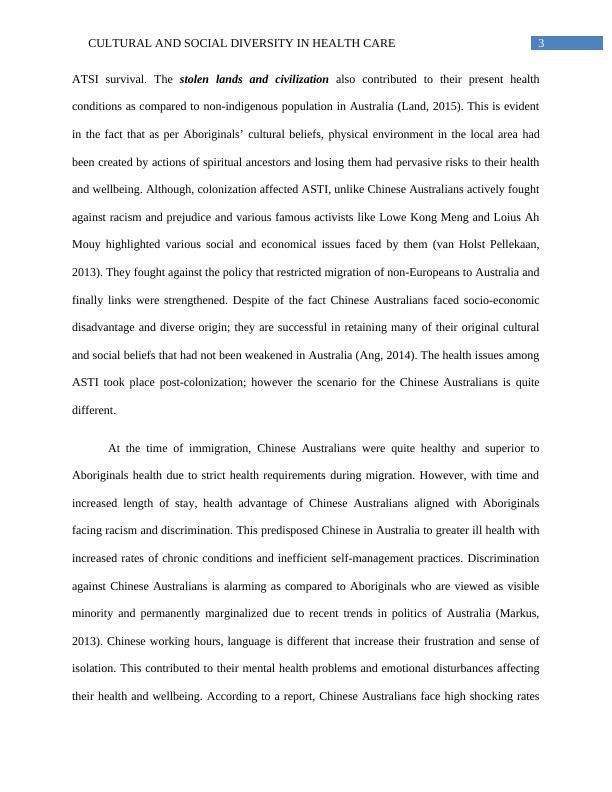Healthcare Assignment | Cultural and Social Diversity
Added on 2020-05-28
12 Pages3281 Words86 Views
Running head: CULTURAL AND SOCIAL DIVERSITY IN HEALTH CARECultural and social diversity in healthcare Name of the StudentName of the UniversityAuthor note

1CULTURAL AND SOCIAL DIVERSITY IN HEALTH CARECultural and historical events greatly influences health migration and incorporatingcomponents of new culture came into origin of a particular culture. The culture and history onhealth is vast affecting perceptions of illness, health, death and beliefs about disease causeshelping healthcare professionals to design and tailor diagnosis, and health promotion approaches(Anderson & Kowal, 2012). Ethnicity and racial differences present a complex structure ofhealth differences predisposing them to risk factors in every dimension. These differences areclear as ethnic or racial groups are rooted in complex interlocked factors of socio-economicstatus. Risk factors include behavioural risk factors that predispose cultural groups to chronicdisease and subjected to abusive behaviours related to it like substance abuse or violentbehaviour (Spector, 2012). Healthcare behaviour also contribute to risk as health seekingbehaviour, avoidance or utilization of healthcare, doctor-patient relationship and compliance tomedical regimens also give rise to varying health differences. For example, Aboriginals andTorres Strait Islander and Chinese families in Australia are subjected to certain risk factors dueto current and historical events in Australia with differences in health outcomes that will bediscussed in the following essay. Moreover, the essay will highlight the influence of service careprovision and healthcare policies on health outcomes of these two cultural groups. Aboriginals and Torres Strait Islanders (ATSI) is the original Australian people that areunrivalled in the whole world occupying traditional lands through the mainland country. TSI onthe other hand occupies 270 islands running in between Papua New Guinea and Australia. Thereare cultural and ethical differences within ATSI societies having own traditions and languagebeing original custodians of Australia (Garling et al. 2013). On a contrary, Chinese Australiansare the second largest immigrants’ source in Australia after India. During the Australian GoldRushes period, Chinese came to Australia shaping and influencing Australian policy for years

2CULTURAL AND SOCIAL DIVERSITY IN HEALTH CARE(Pang, Alfrey & Varea, 2016). Racism is one of the main driving factors that affected AustralianFederation. This immigration depicts that there was bimodal distribution of Chinese in Australiawhere some tended to face language difficulties and experienced high unemployment rate. Instark contrast, Few Chinese came as business or professional migrants who brought great wealthand skills with them. On a contrary, Colonization and assimilation of government intomainstream Western society has an impact on every aspect of ATSI life including traditionalroles, health, socio-economic conditions, health equity, access to services and culture(Tousignant & Sioui, 2013). The policies and procedures post- colonization by governmentassimilation had contribute to the Aboriginal people marginalization from the mainstreamsociety having a disruptive and profound impact on their health, access to healthcare services,socio-economic welfare and culture around the world. This resulted in reduction of AustralianAboriginal population by 90% between 1788 and 1900 (Haskins & Lowrie, 2014). The abovecomparison shows that being the original people in Australia, ASTI faced discrimination andmarginalization post-colonization practiced even today. However, Chinese Australians beingimmigrants left a mark on the Australian history changing the phase of present Australiansociety. After the British settlement, there was appearance of European diseases being theimmediate consequence of British colonization like smallpox, chicken pox, measles andinfluenza (Greenwood & de Leeuw, 2012). These are infectious disease spread quickly amongthe Aboriginal communities on a large scale. Moreover, the nomadic life of Aboriginals wasdisrupted as they were driven away from their lands resulting in reduction of access to waterresources and land (Tuck & Yang, 2012). By 1980s, all Aboriginal lands were taken away bywhite settlers and already weakened by appearance of new diseases; it reduced the chances for

3CULTURAL AND SOCIAL DIVERSITY IN HEALTH CAREATSI survival. The stolen landsand civilization also contributed to their present healthconditions as compared to non-indigenous population in Australia (Land, 2015). This is evidentin the fact that as per Aboriginals’ cultural beliefs, physical environment in the local area hadbeen created by actions of spiritual ancestors and losing them had pervasive risks to their healthand wellbeing. Although, colonization affected ASTI, unlike Chinese Australians actively foughtagainst racism and prejudice and various famous activists like Lowe Kong Meng and Loius AhMouy highlighted various social and economical issues faced by them (van Holst Pellekaan,2013). They fought against the policy that restricted migration of non-Europeans to Australia andfinally links were strengthened. Despite of the fact Chinese Australians faced socio-economicdisadvantage and diverse origin; they are successful in retaining many of their original culturaland social beliefs that had not been weakened in Australia (Ang, 2014). The health issues amongASTI took place post-colonization; however the scenario for the Chinese Australians is quitedifferent. At the time of immigration, Chinese Australians were quite healthy and superior toAboriginals health due to strict health requirements during migration. However, with time andincreased length of stay, health advantage of Chinese Australians aligned with Aboriginalsfacing racism and discrimination. This predisposed Chinese in Australia to greater ill health withincreased rates of chronic conditions and inefficient self-management practices. Discriminationagainst Chinese Australians is alarming as compared to Aboriginals who are viewed as visibleminority and permanently marginalized due to recent trends in politics of Australia (Markus,2013). Chinese working hours, language is different that increase their frustration and sense ofisolation. This contributed to their mental health problems and emotional disturbances affectingtheir health and wellbeing. According to a report, Chinese Australians face high shocking rates

End of preview
Want to access all the pages? Upload your documents or become a member.
Related Documents
Diet and Nutrition of Aboriginal and Torres Strait islander3 Case Study 2022lg...
|6
|1363
|22
Aboriginal and Torres Strait Islander Health: Social, Political, Economic and Cultural Factorslg...
|6
|1246
|346
Contemporary Indigenous Issues (DOC)lg...
|16
|4299
|81
Factors Impacting Health Outcomes of Australian Culturally Diverse Communitieslg...
|12
|3064
|377
Healthcare Issues in Australia: Challenges Faced by Aboriginal Populationlg...
|4
|523
|267
Health And Welfare Of Social Concernslg...
|16
|4391
|14